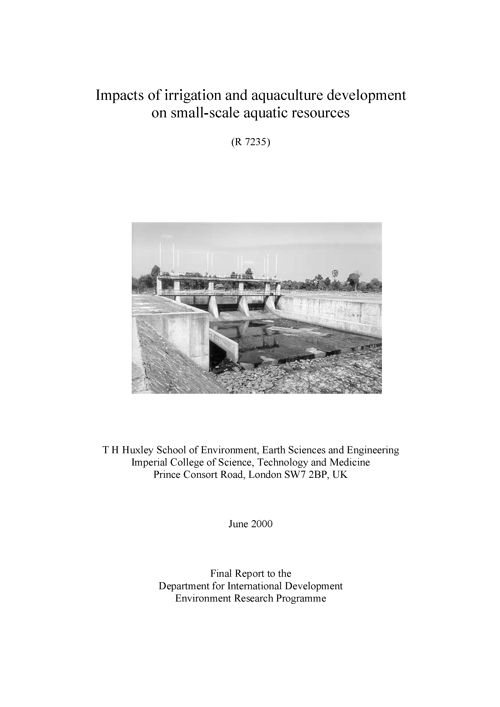Impacts of irrigation and aquaculture development on small-scale aquatic resources
11 December 2003 | Kai Lorenzen, Sophie Nguyen Khoa, Caroline Garaway, Robert Arthur and Geoff Kirkwood | 1063 Downloads | .pdf | 471.03 KB | Genetics and Biodiversity, Livelihoods, gender and social issues
Small-scale aquatic resources play an important but poorly quantified role in the livelihoods of rural people in many developing countries, and are also important reservoirs of biological diversity. We conducted a field study in Southern Laos to quantify small-scale aquatic resource, and to assess the impacts of (small-to-medium scale) irrigation and aquaculture development on these resources.
The main resource use and irrigation impact study has been designed as a paired comparison of household fishing effort and yield, and fish species richness between impacted and non-impacted sites for the three main types of irrigation schemes found in the project area. A total of 31 paired sites with 620 households were surveyed.
Participation in natural aquatic resource use was near universal, with 83% of households fishing during the survey period. The estimated average annual household catch was 60 kg, with a market value of 90 US$. This represents about 15-20% of average household income. Household fishing effort and catch were strongly related to household size, but only weakly influenced by socio-economic status.
Weir irrigation schemes were associated with a 40% (90%CI [5%, 67%]) reduction in household fish catches from a non-impacted mean of 30 kg/hh/year. This difference reflects a change in fishing effort as well as in resources abundance.
Dam irrigation schemes were associated with no significant overall effect on household catches in villages in the vicinity of the newly created reservoir. However, catches from floodplain areas declined significantly by 58% (90%CI [2%, 90%]) from a non-impacted average of 78 kg/hh/year. This was largely but not fully compensated by increased catches from the reservoir. Again, differences reflect a change in fishing effort as well as in resources abundance.
Reservoirs should not be regarded as adding to total aquatic habitat and productivity, but as (partial) compensation for downstream impacts. Net impacts may be spatially differentiated, and overall negative impacts may occur downstream of the dam where the reservoir is less accessible.
Pump irrigation schemes abstracting from major rivers had no significant effect on catches from the irrigated areas.
None of the irrigation schemes had significant effects on fish species diversity. Measured effects on species richness were as follows: weirs –3% (90%CI [-30%, +16%]), dams +8% (90%CI [-22%, + 30%]); pumps (irrigated area) –13 (90%CI [-31%, +4%]).
It is concluded that the development of individual, small-to-medium scale irrigation schemes is associated with moderate, but significant negative impacts on local aquatic resources. However, these resources can remain productive and diverse and add substantial value to the use of water in irrigation.
Aquatic resources impacts should be considered in cost-benefit analyses and environmental assessments of small and medium scale irrigation schemes.
Proliferation of small-to-medium scale irrigation schemes may lead to cumulative impacts in excess of those established here. This should be assessed and managed on a catchment scale.
The aquaculture impact study consisted of two surveys. One survey quantified the effects of successful adoption of aquaculture on natural aquatic resource use. A separate survey was designed to compare fish species richness between small water bodies with and without established feral populations of Nile tilapia.
Aquaculture has been adopted by 7% of households in the project area, and the estimated contribution to fish catches of aquaculture is 2-10%. In the survey periods, adopting households obtained 20% more fish while expending 18% less effort than non-fish farmers.
Aquaculture adoption occurred across a wide range of socio-economic groups, but was dominated by households with high levels of asset ownership and cash income.
Aquaculture adoption resulted in a significant reduction (-36%) of household fishing effort, but only small reduction in household catch from natural aquatic resources.
The establishment of feral tilapia populations (as a result of escapement from fish ponds or deliberate stocking) had no significant effect on wild fish species richness.
It is concluded that aquaculture expansion is unlikely to have a major effect on the use or diversity of natural, small-scale aquatic resources.
Copyright, all rights reserved.

